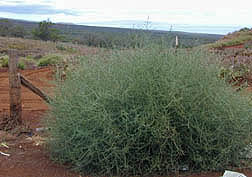This page has been archived and is being provided for reference purposes only. The page is no longer being updated, and therefore, links on the page may be invalid.
|
|
|
|
New Approach Could Improve Safety Assessments of Biocontrol Pathogens
By Jan SuszkiwMarch 19, 2009
Determining the host range of fungal pathogens that have potential for use as biological controls of weeds should become easier to do, thanks to a new technique developed by Agricultural Research Service (ARS) scientists.
Their approach combines data in unique ways to improve predictions about how certain plants or crops related to a targeted weed might react to the release of a candidate pathogen used in a classical biocontrol program.
Existing methods of determining a pathogen's host range can be labor-intensive, too reliant on narrow data sets, or impractical to use when numerous or hard-to-grow plant species are involved. The new approach also diminishes uncertainty as to whether the reactions of greenhouse-grown plants will reflect the species as a whole under field conditions, according to a paper published in Biological Control and authored by Dana Berner, Bill Bruckart, Craig Cavin and Jami Michael, who work at the ARS Foreign Disease-Weed Science Research Unit in Frederick, Md.
Their approach involves integrating plant-disease reaction scores and other data with a matrix made up of DNA sequence information that shows the genetic relatedness of plant species to each other and to the target weed. Using a statistical approach similar to so-called "animal mixed models," scientists can predict the probable susceptibility of different plants to the weed pathogen. This may also narrow the list of plants necessary for planning quarantine studies.
Berner's team has used the approach to determine the host range and safety of releasing the rust fungus Uromyces salsolae for biological control of Russian thistle, Salsola tragus, more commonly known as tumbleweed. Of 64 species analyzed using the mixed-model equation, only seven--all Salsola--showed susceptibility to the fungus, indicating its high specificity.
Although symbolic of the Wild West, tumbleweed is a noxious pest. It can infest crop fields, harbor pathogens, deplete soil moisture, pose a fire hazard and endanger motorists. Biocontrol offers a sustainable alternative to herbicide spraying and physical controls like mowing, especially across large swaths of infested land.
ARS is the principal intramural scientific research agency of the U.S. Department of Agriculture.

